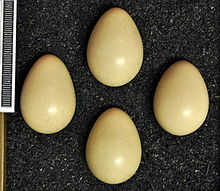Bearded partridge
| Bearded partridge | ||||||||||||
|---|---|---|---|---|---|---|---|---|---|---|---|---|

Bearded Partridge ( Perdix daurica ) |
||||||||||||
| Systematics | ||||||||||||
|
||||||||||||
| Scientific name | ||||||||||||
| Perdix daurica | ||||||||||||
| ( Pallas , 1811) |
The bearded partridge ( Perdix daurica ) is a species from the pheasant-like family that inhabits shrub habitats in forest steppes, steppes and semi-deserts of Central Asia.
There are three subspecies. It is closely related to the partridge it replaces in the east of the Palearctic. The two species overlap in a large area. Despite the striking similarities, natural hybrids are relatively rare.
Appearance
The bearded partridge reaches a body length of 28 to 30 centimeters and weighs between 200 and 340 grams. It has a gray-brown beak and brown eyes. The bare skin behind and under the eyes is red, which is particularly noticeable in the males. The legs are grayish flesh-colored. The sexual dimorphism is only very slight. Females are generally a little paler in color.
The forehead and sides of the head as well as the chin and throat are cinnamon colored. The back of the neck as well as the sides of the neck and the chest are drawn in a fine gray. In the middle of the underbust there is a black-brown to black horseshoe-shaped spot. The lower abdomen are pale brownish. The top of the body is matt gray-brown.
The bearded partridge can be distinguished from the partridge by the very dark (not brownish) belly spot and the light reddish color on the chest and upper part of the abdomen.
Distribution area and habitat
The distribution area of the bearded partridge extends over the steppe and semi-desert areas of Inner Asia from Fergana and Semiretschje to the Ussuri estuary , in the south to the eastern Tienschan , the upper reaches of the Yellow River and the provinces of Shaanxi and Shanxi in the People's Republic of China . It overlaps with the partridge in central Siberia, western China, and eastern Kazakhstan . There are obviously different requirements for the breeding area, which prevent the two species from hybridizing more strongly in these regions. In Kazakhstan, for example, the partridge is found in the plains, while the bearded partridge prefers shrubby slopes and more tree-covered areas.
The bearded partridge inhabits a wide range of different habitats, but shows a preference for shrubby or light tree-covered areas that border on grassland. But it also occurs in tree-lined steppe, grassy forest clearings, in shrub regions along rivers and in agricultural land. In some areas it also occurs on semi-arid rocky slopes, but generally it avoids desert regions. In Central Asia, the bearded partridge is also found on salt marshes with salt bushes. On the steppe slopes of mountains it breeds locally at altitudes up to 2400 meters above sea level.
The largest part of the population are resident birds. Only in the extreme north of the distribution area do bearded partridges leave their breeding area in winter and move to more southerly, snowless areas.
Habits
The bearded partridge is a hen bird that lives socially for most of the year. It usually occurs in chains of 15 to 30 individuals. In the winter months, however, the chains can also include up to 200 individuals. It has a monogamous mating behavior. The break-up of the winter groups into individual pairs takes three to four weeks. Old individuals begin to reproduce a little earlier than the young ones. The nest is a hollow in the ground with grass, leaves, roots and soft feathers. The clutch usually comprises 18 to 20 eggs. Clutches with fewer than 12 eggs are very rare. In shape and color, the eggs are indistinguishable from the eggs of the partridge. Unlike the partridge, the chicks are led by the female and the male. The young can already flutter at a week old.
literature
- Steve Madge , Phil McGowan, and Guy M. Kirwan : Pheasants, Partridges and Grouse. A Guide to the Pheasants, Partridges, Quails, Grouse, Guineafowl, Buttonquails and Sandgrouse of the world. Christopher Helm, London 2002, ISBN 0-7136-3966-0 .
- RL Potapov, VE Flint (HRSG): Handbook of Birds of the Soviet Union. Volume 4: Galliformes, Gruiformes. Aula Verlag, Wiesbaden 1989, ISBN 3-89104-417-8
